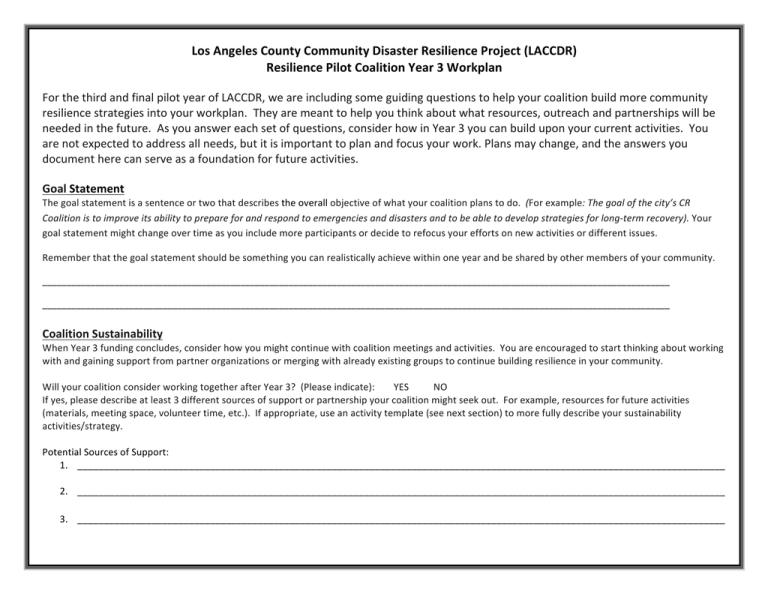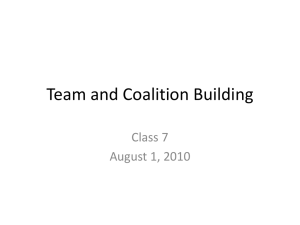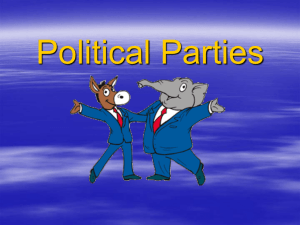Document 12310254
advertisement

Los Angeles County Community Disaster Resilience Project (LACCDR) Resilience Pilot Coalition Year 3 Workplan For the third and final pilot year of LACCDR, we are including some guiding questions to help your coalition build more community resilience strategies into your workplan. They are meant to help you think about what resources, outreach and partnerships will be needed in the future. As you answer each set of questions, consider how in Year 3 you can build upon your current activities. You are not expected to address all needs, but it is important to plan and focus your work. Plans may change, and the answers you document here can serve as a foundation for future activities. Goal Statement The goal statement is a sentence or two that describes the overall objective of what your coalition plans to do. (For example: The goal of the city’s CR Coalition is to improve its ability to prepare for and respond to emergencies and disasters and to be able to develop strategies for long-­‐term recovery). Your goal statement might change over time as you include more participants or decide to refocus your efforts on new activities or different issues. Remember that the goal statement should be something you can realistically achieve within one year and be shared by other members of your community. __________________________________________________________________________________________________________________________________ __________________________________________________________________________________________________________________________________ Coalition Sustainability When Year 3 funding concludes, consider how you might continue with coalition meetings and activities. You are encouraged to start thinking about working with and gaining support from partner organizations or merging with already existing groups to continue building resilience in your community. Will your coalition consider working together after Year 3? (Please indicate): YES NO If yes, please describe at least 3 different sources of support or partnership your coalition might seek out. For example, resources for future activities (materials, meeting space, volunteer time, etc.). If appropriate, use an activity template (see next section) to more fully describe your sustainability activities/strategy. Potential Sources of Support: 1. __________________________________________________________________________________________________________________________ 2. __________________________________________________________________________________________________________________________ 3. __________________________________________________________________________________________________________________________ Priority Vulnerable Community Members What can make community members more vulnerable? • Inability to move around easily (e.g., disability, no car, no transportation); • Inability to communicate (e.g., language barriers, factors that prevent you from perceiving information about the world around you such as hearing, vision, sensory, no telephone service); • Inability to care for yourself (e.g., no insurance, living in poverty, long-­‐term illness; cognitive disability); • Unable to access resources (housing; low social capital at the community level). For this project, vulnerability can be defined as the reduced capacity of an individual or group to prepare for, cope with, resist and recover from the impact of a disaster or emergency. A big part of community resilience is the importance of including and planning for the needs of vulnerable people and groups. -­‐ Listyour most vulnerable community members. ________________________________________________________________ -­‐ What are the limitations that they face in either mobility, communications, or resources that make them particularly vulnerable in a disaster? __________________________________________________________________________________________________________________________ -­‐ How (using mapping tools or other processses) are you identifying who and where they are located? __________________________________________________________________________________________________________________________ -­‐ -­‐ How are you including them and their needs in your planning process? _____________________________________________________________________________________________________________________________ What are the assets, resources, and networks that vulnerable community members already have and how are you using them? These can include churches, social clubs, neighborhood or community associations. _____________________________________________________________________________________________________________________________ Understanding Your Community Mapping tools and processes can help identify and prioritize the hazards in your area as well as resources, and assets in your community. -­‐ What mapping tool or other process are you using to identify the hazards and resources in your community? __________________________________________________________________________________ -­‐ Suggested mapping tools: -­‐ Sahana (http://lacrmt.sahanafoundation.org/) -­‐ Map Your Neighborhood (http://www.emd.wa.gov/myn.index.shtml) -­‐ Healthy Cities (http://www.healthycity.org/ ) How are you using the information you collect to get your neighbors and your community prepared, ready to respond, and able to recover from a disaster or emergency? _____________________________________________________________________________________________________________________________ -­‐ How are you encouraging neighbor-­‐to-­‐neighbor discussion or planning to support one another in a disaster emergency? _____________________________________________________________________________________________________________________________ Important Sectors in Your Community Resilience is all about moving your community from “me” to “we”. To build community resilience, it is necessary to develop community partnerships and build on community preparedness networks and social connections. For each of your listed strategies/activities in the activity template (next section), you will be asked to indicate how Twelve Important Sectors in Your Community different sectors are included and contributing to your work. • Business • Community Leadership Engaging different sectors in your work builds communication between agencies, helps to avoid • Cultural and Faith-­‐based Groups/Organizations overlap, and keeps information flowing. This is especially important during times of disaster or • Emergency Management emergency. Specifically, how is your coalition coordinating the work of first responders and • Healthcare community members to keep lines of communication open? • Social Services • Housing and Sheltering ______________________________________________________________________________ • Media • Mental/Behavioral Health • State Office of Aging/Equivalent • • Education Childcare Recovery Recovery is the process that helps your community restore its health, property and essential services after a disaster or emergency. -­‐ How are organizations and agencies in your community involved in planning for the recovery process? For example, organizations like schools, clinics, faith-­‐ based organizations. If appropriate, use an activity template (see next section) to describe your recovery activities/strategies. ________________________________________________________________ -­‐ -­‐ Planning for recovery includes: -­‐ Understanding resources available to recover and rebuild personal and community property (e.g., homes, parks, community centers) -­‐ Understanding strategies to restore community services (e.g. schools, businesses, faith o rganizations, clinics, and health centers) -­‐ Developing processes for receiving d onations and using volunteers for recovery purposes -­‐ Having strategic recovery partners (e.g. government agencies, schools, businesses, faith organizations, clinics, and health centers) -­‐ Having a plan for addressing the immediate and long term psychological and emotional needs of the community and responders List three ways your coalition is planning to help families, neighborhoods, and the community recover as a whole? 1. _________________________________________________________________________________________________________________________ 2. __________________________________________________________________________________________________________________________ 3. __________________________________________________________________________________________________________________________ How will organizations and agencies in your community continue to help their current clients as well as the wider community? For example, places like clinics, senior centers, food banks and child care? _____________________________________________________________________________________________________________________________ Measuring Your Success With all the hard work and planning that your coalition is taking on, you will need tools to document that your activities are making a difference. Think of the desired outcomes that you ultimately want the activities to accomplish, and what will indicate whether, and to what degree, you are making progress. For each of your listed strategies/activities in the activity template (next section), you will be asked to think through what sorts of results you expect, how you will collect the information, and if this will inform your next steps. • • • Evaluation Resources Free Management Library http://managementhelp.org/evaluation/program-­‐evaluation-­‐ guide.htm United Way http://www.nrpa.org/uploadedFiles/nrpa.org/Professional_Devel opment/Accreditation/COAPRT/Measuring_Program_Outcomes-­‐ UW.pdf W.K. Kellogg Foundation Evaluation Handbook http://www.wkkf.org/resource-­‐directory/resource/2010/w-­‐k-­‐ kellogg-­‐foundation-­‐evaluation-­‐handbook Sharing Your Work with Your Community Check out these w ebsites for tips and resources to guide in planning your own All the activities your coalition has conducted should be shared with community forum: the wider community. Sharing your work is an important part of -­‐ http://www.communityplanning.net/methods/community_planning_forum.php building community resilience so that the whole community can -­‐ http://www.civilrights.org/action_center/forum/ benefit from the work you’ve done and lessons learned. Sharing your work with community informs others about how they can be better prepared, what community resources are available and what hazards they need to be aware of. It is also a critical opportunity to encourage other community partners and sectors to participate. For example, a community forum is one strategy to share the work of the coalition and to invite and engage stakeholders from different sectors into the coalition’s work. A community forum can be anything from a highly publicized community meeting, a panel presentation, or a discussion group with guest experts at a smaller gathering. Please describe three ways you will share your plan, activities, and successes with the broader community. If appropriate, use an activity template (see next section). 1. _________________________________________________________________________________________________________________________ 2. __________________________________________________________________________________________________________________________ 3. __________________________________________________________________________________________________________________________ Workplan The activity template below allows your coalition to identify the problem(s) or issue(s) in your community and then provide detailed information about what you plan to do and the type of change it will create. Please complete one activity template table for each type of activity you plan to conduct during Year 3 (Fall 2014 – June 30, 2015) of the LACCDR Pilot Project. Copy and paste as many templates as needed to capture the Year 3 activities for the Coalition. STRATEGY/ACTIVITY The Problem/Issue Describe a problem or issue in your community, including the population of concern, the hazard or risk, and why it is important to address this issue or problem: Description of Activity or Strategy What activity would you like to do to address the problem or issue? Important Sectors in Your Community -­‐ Business -­‐ Community Leadership -­‐ Cultural and Faith-­‐based groups/organizations -­‐ Emergency Management -­‐ Healthcare -­‐ Social Services -­‐ Housing and Sheltering -­‐ Media -­‐ Mental/Behavioral Health -­‐ State Office of Aging/ equivalent -­‐ Education -­‐ Childcare -­‐ How are you getting organizations and agencies from the 12 sectors involved? -­‐ List the organizations/individuals to be involved with the activity and which sector. Indicate which are already on board, who is to be invited, and what roles they will play. -­‐ How are/will you be using the services and resources of these organizations and agencies to complete this activity or strategy? Estimated Date (Month/Year): If the activity will extend over time, include a date range (for example, Jan 2015 – March 2015) List of Action Items and Person(s) Responsible Action Item/Due Date Person(s) Responsible Measuring your success -­‐ -­‐ -­‐ -­‐ Need for additional resources Other than financial resources, please state resources that would help the coalition complete this activity and achieve the outcome? Examples might include research, technical assistance, support with evaluation and tracking, etc. Additional Resources and Technical Assistance Other than financial resources, what supports can the LACCDR team provide (e.g., research, TA, support with evaluation and tracking) that will help you to complete this activity and to achieve your goal? Additional Notes: What will be different or improved after this activity is completed? How will you track your progress? How will you know if your activities are working to accomplish your goal and purpose? How will you use the information you collect to refine and guide future activities?



